Mark Thompson is taking us to the Dark Side. The director for the single-player campaign of Star Wars: Battlefront II has created a story where you can play the baddies. In this story, you play as Iden Versio, an Imperial special forces commander who happens to be on Endor as the second Death Star blows up at the end of The Return of the Jedi.
I played the prelude and first two chapters of Battlefront II’s single-player campaign, and then I interviewed Thompson about it afterward. In the multiplayer version of Battlefront II, you’ll be able to play villains and heroes from every Star Wars era, including Kylo Ren, Rey, Darth Maul, Yoda, and Iden Versio. But in the single-player campaign, you are rooted in the post-Death Star explosion timeline and Versio’s story.
In the campaign, Versio starts out as a captive. She escape the Rebel forces and makes her way to Endor, where she witnesses the Death Star’s demise. She shows no emotion, and begins executing orders and taking out Rebels. She fights her way to a Tie Fighter and then takes off into space. From there, the story takes some interesting twists. During the subsequent events, we’ll see how Versio’s loyalty to the Empire, and her own father, holds up. I asked Thompson about this and he said the storytelling takes us to the edge of that question.
Here’s an edited transcript of our interview.
June 5th: The AI Audit in NYC
Join us next week in NYC to engage with top executive leaders, delving into strategies for auditing AI models to ensure fairness, optimal performance, and ethical compliance across diverse organizations. Secure your attendance for this exclusive invite-only event.
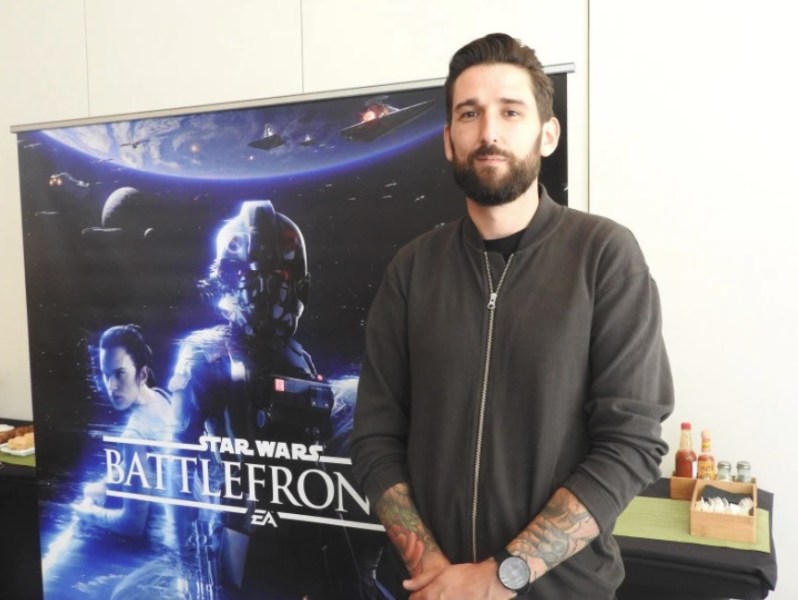
Above: Mark Thompson, game director at EA Motive on Star Wars: Battlefront II single player.
GamesBeat: Could you describe the campaign a little bit? The prelude, Chapter One, is pretty short. Chapter Two starts getting longer. By that time it seems like you’re fully trained. Is that where you wanted to onboard people?
Mark Thompson: It’s a huge game, and the campaign is just one small part of the Battlefront experience. We don’t really know how people are going to come to the campaign. Some people could have 200 hours of multiplayer experience before they even touch the campaign. We know that Battlefront appeals to people who just want to play online, right? Then there are people who maybe just want to play single-player content, but they could play hours of couch co-op or arcade. With Battlefront, co-op is used in family and friends situations — bring in a Star Wars fan who isn’t necessarily a gamer and show them how fun it can be to interact with Star Wars. We don’t really know how people are going to approach the campaign, how much experience they have.
In terms of onboarding we have to do a lot. We have to introduce people to new characters. We have to tell them where it’s happening, when and why, who you are. The prologue was that idea of, show people what it’s like to be an Imperial special forces agent, to be a captive prisoner who outsmarts their captors and then escapes through unorthodox means in a very high-stakes operation.
GamesBeat: It seemed like the shooting, at first, was fairly gentle. Easy targets. They didn’t hit you so much. But then I ran into my first heavy gunner, and I had to take cover. You can’t just expose yourself.
Thompson: The overall design philosophy of Battlefront is to have accessibility with depth. Especially that’s marked the design difference between Battlefront and Battlefront II. You make sure the first touch is welcoming. Star Wars fans of all levels of experience can come in and enjoy the game. But then you slowly ramp people up with new abilities, new skills, and new challenges.
The AI system itself, the AI classes, they’re all designed around the class-based system from multiplayer. In the single-player campaign we wanted you to meet opponents that were built on those classes. That heavy gunner is the heavy class from multiplayer.
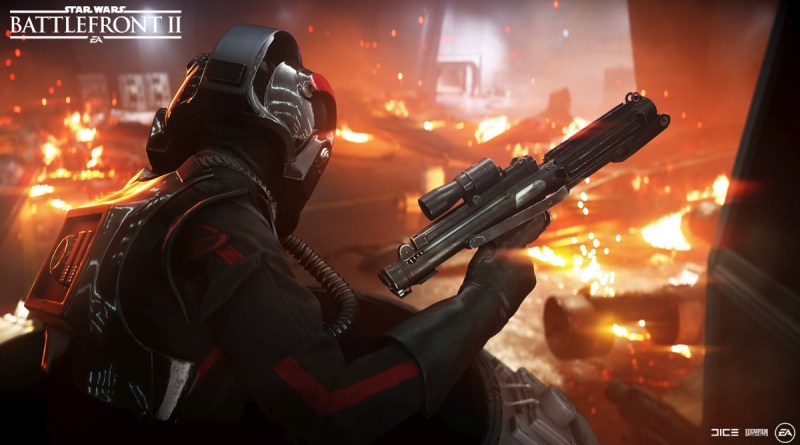
Above: Iden Versio in Star Wars: Battlefront II
GamesBeat: It seems important to pay attention to your bumpers. The drone ability to disable something and things like that. That seems to be where you’re adding more skill, but there’s some depth that newcomers may or may not use.
Thompson: It’s all part of the design approach around accessibility. You don’t need to use any of those abilities, but you can. You don’t have to change them. You don’t have to go to the loadout and think about how you want to approach a different scenario. You could play through the entire game just using the droid scan instead of using the droid shield, for example.
But just as in multiplayer, the star card system exists to add an extra level of depth and customization and a higher skill ceiling. The mental programming you’re talking about — looking to the bumpers and thinking about the star cards — that’s something that is going to be useful if you play campaign and you go across to multiplayer, or if you play a lot of multiplayer and then come across to the campaign. It’ll feel familiar and rewarding that you have the same star card system and controls.
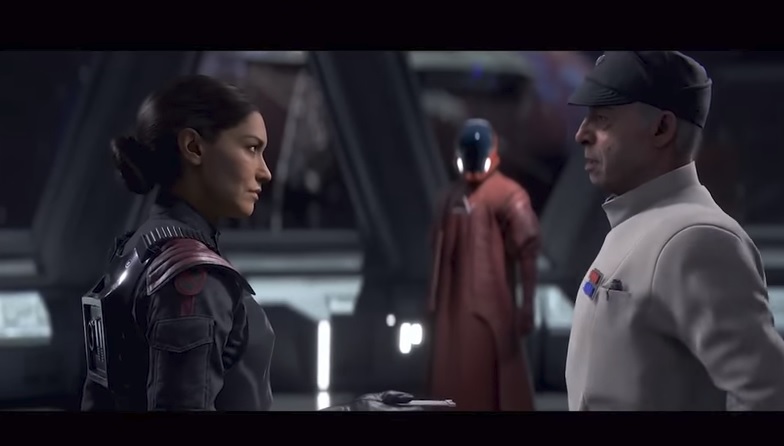
Above: Iden Versio talks to her father, Garrick, an Imperial admiral.
GamesBeat: With Iden, it seemed like she was very confused about what’s going on. It sort of reflects — I’m confused as well. Why would her father order an attack on an Imperial planet? You’re setting up something interesting there. Is it an inner conflict that she has, which duty she has to remain loyal to?
Thompson: One of the themes we’re exploring, just from a storytelling point of view, is the idea that the Empire sells itself internally as a path to peace through order and stability. That’s what it brings to the galaxy. It frames the Rebellion as antithetical to that. They’re about instability and chaos. Iden, having grown up in an Imperial utopia as part of an Imperial family, has only seen the propaganda side. She’s seen the galaxy through that lens of peace through control and order.
In the wake of Endor, when the Empire becomes more chaotic, that clashes with her ideology of why the Empire is good and what the Empire is supposed to do. As a character, we wanted to personify somebody inside the Empire. It’s powerful when a Stormtrooper takes off her helmet. We have a joke internally — somebody on the team told me this story early on. When they were a kid, they thought the Stormtroopers were robots, because they never took their helmets off. Years later they realized it’s people in armor. It’s powerful to take off the helmet and explore a person.
In doing that we wanted to create a character that had some personality, that would call people out on their bullshit if they believed somebody was doing something wrong. We didn’t want to go to the trouble of humanizing a character in the Empire and just have them be the physical and ideological embodiment of the Empire, because that wouldn’t be an interesting story. Drama comes through conflict.
GamesBeat: It brings up some echoes of things like Princess Leia seeing her planet destroyed, or historical parallels. Are there inspirations you see when you’re putting together that conflict?
Thompson: Obviously when we’re telling the story — there are recurring themes in Star Wars storytelling. There are pillars that go into a Star Wars story. There are strong themes of family, so it’s no surprise that in this story, as with all Star Wars stories, there’s a family at the heart of it. It’s just natural. As people, we gravitate toward stories that involve families because that’s central to everyone’s life.
GamesBeat: Father issues are especially a recurring theme.
Thompson: It’s also issues of commander and subordinate, right? One of the things that’s interesting about that relationship specifically is exploring the idea of a father and a daughter who are also an admiral and a subordinate. Especially inside something like the Empire, where you aren’t allowed to openly express emotion. When Garrick tells his daughter that the Emperor is dead, that could be a heartbreaking moment for Iden. He’s obviously — it’s very emotionally charged, but at the same time they have to be restrained. Not only because they have this weird messenger droid that might be recording them and broadcasting that elsewhere as a test of their loyalty, but because in the rigid confines of the Empire, they have to suppress their emotions.
GamesBeat: She seemed to be pretty good at holding that in.
Thompson: Sometimes it boils over. Humans make mistakes and do things in the heat of the moment.
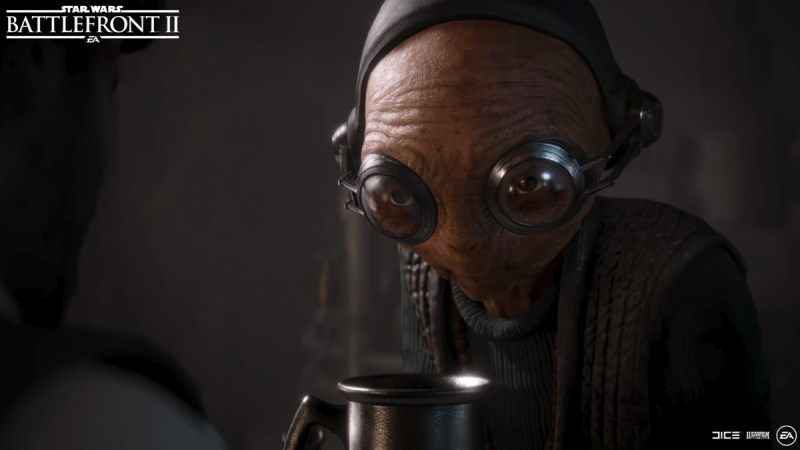
Above: This sure looks like Maz Kanata from The Force Awakens.
GamesBeat: In her facial expression, you can tell that she’s silencing herself.
Thompson: That’s what’s great about where we are with technology, in terms of facial performance and motion capture. Maybe 10 years ago, the subtlety of what you’re seeing in the performance would have been lost. It would have just seemed like these people were stilted and wooden. Now, though, when someone’s on stage living and breathing that moment, we can see that in the game, which is fantastic.
GamesBeat: Does this campaign address some things that fans have been wondering about, these first few missions?
Thompson: What’s fantastic about Star Wars — you release the smallest details, and it gets extrapolated into these wild theories about what’s happening and why. I’m excited to get more out there and start to see people exploring the fringes of the story – all the things we’ve put in there and hinted towards and connected to other pieces of storytelling.
Working with Lucasfilm is great. They have this central group, the story group, whose job it is to keep all these different plates spinning. They can point us in the direction of — “Hey, we used this ship in this board game. Maybe it would be cool to use this for Inferno Squad. And we have this character in a certain location from this novel. Maybe you could explore that as well.”
It’s about making organic connections. It’s not just about forcing things in there that don’t belong. At the heart of that group at Lucasfilm — we have two teams we work with primarily. There’s the game production team, going back to the LucasArts days, and then the story group, who live and breathe Star Wars storytelling. They don’t want to put anything in that doesn’t belong. We end up with this very organic series of connections, because the galaxy is huge. There are so many things to draw from. You don’t have to force in a connection to a character that doesn’t belong.
GamesBeat: We haven’t seen any well-known Star Wars characters yet. Should we expect to see anyone in particular in the campaign?
Thompson: There will be a lot of the most iconic characters. Obviously because — today we didn’t want to reveal too much in terms of story and what happens. We also wanted this to serve as an introduction to the who, what, where, when, and why of Inferno Squad. We didn’t want to get into too many details. But the story will touch other parts of the universe and iconic characters. From a gameplay point of view, going back to those three player fantasies we talked about – being a pilot, being a trooper, and being a hero – in the campaign there are chapters where you play as the iconic heroes of Star Wars.
When we developed the story, we looked at what are the hallmarks of Star Wars storytelling. But obviously we wanted to bring new things to Star Wars. You have to find a comfortable space between something that’s familiar, that seems authentic, that feels like it belongs in Star Wars — something feeling Star Wars is so intangible, right? It’s hard to quantify. There’s something magical about it. It’s a challenge to capture that and make it feel true when you’re talking about new characters, new locations, and new events. You can’t just make any old story and put wipes between the scenes and call it Star Wars. There’s more to the DNA than that.

Above: Star Wars: Battlefront II features a father-daughter story.
GamesBeat: It seems like player feels something very different being on the Empire’s side. Can you describe that some more? It almost seems like a foreign idea, given that we’ve seen Imperial forces commit so many atrocities, that they would question orders.
Thompson: When you think about it, the daily job of a Stormtrooper is to receive an order and execute that order. As an audience, we have the privilege of seeing exactly why and when things happen. What we don’t know is how the Death Star was communicated or talked about inside the Empire. We were there inside the ship and we saw the order to destroy Alderaan, just to intimidate a Senator. But we don’t know how that event was communicated back to the wider Empire. Were they told that Alderaan was housing a superweapon aimed at Coruscant? We don’t know the narrative that was spun around that. We don’t know if everyone in the Empire uniformly understands what that was, or if they didn’t know what that was and believes it was the right course of action.
That’s part of taking the helmets off and meeting these people and seeing that they are people who fight for the Empire because they believe in that cause. They’re not mustachioed villains. They don’t believe they’re on the wrong side of history, because they don’t have the perspective we do as an audience, having seen all these events first-hand. A lot of the story is about experiencing these things from Iden’s perspective and making it more personal.
The movie stories are grand and sweeping in scale. It’s very much about the fate of the galaxy and following the journey of an unlikely hero who goes on the classic hero’s journey and discovers that they’re powerful and that they have a destiny. We didn’t want to do that same kind of story for Iden. It was more personal and grounded in what it means to be a soldier.
We can still have these events happen against the backdrop of something big and galactic, though. On Endor you’re on the ground when the Death Star explodes. But Iden’s perspective is, having seen that happen and felt that emotional impact, can she maintain control, still be a leader, and ensure that her squad manages to survive and escape? That’s her only order at that time. It’s a more personal perspective.
Then, when she sees Operation Cinder challenging her father to launch this attack on their home planet—that’s almost her version of the Death Star, but again, grounded in a very personal scale. She’s confronted with the reality of what the Empire can do. Especially because, after Palpatine is dead, the Empire becomes more chaotic and more — it doesn’t have that same kind of control that Iden believes in as a strength of the Empire.
GamesBeat: What you described almost reminds me more of a Battlefield story.
Thompson: It’s us trying to tell a story that remains true to the identity of Battlefront. It’s about being a soldier. It would be strange if we told a story in Battlefront about a moisture farmer who discovers his grand destiny to become an all-powerful Jedi.
GamesBeat: My boss wants to know if he can shoot Jar-Jar.
Thompson: I can’t make any promises. [Laughs] The campaign is all set after the prequel era, obviously.
GamesBeat: What about Ewoks?
Thompson: The Ewoks are on Endor. If you look up in the trees you can see them running around.
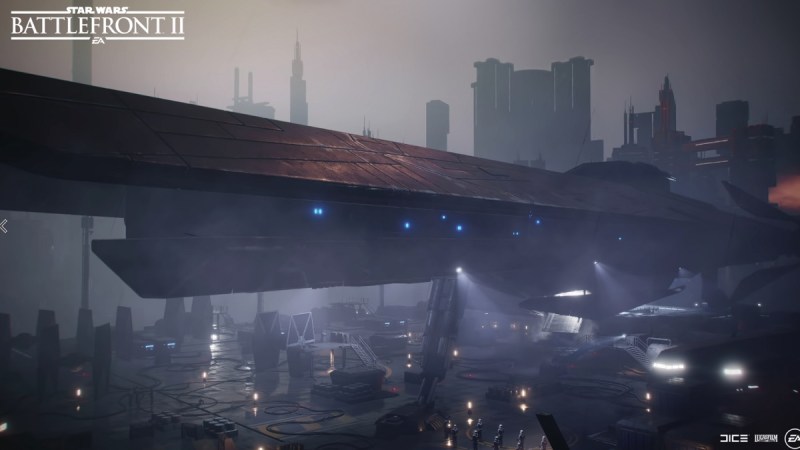
Above: Star Wars: Battlefront II
GamesBeat: I think back to something like The Force Unleashed as another interesting story that was somewhat outside the lore, but did a good job of connecting the dots between the films. Do you see an opportunity here to do something like that, filling in missing pieces?
Thompson: It’s always a good opportunity to explore and think about things in the movies that you take for granted, because they’ve existed in movies you’ve seen a dozen times. We can drill down and think about what happened and when and why. How do you connect this thing to this other thing? That’s where working with Lucasfilm is great. They either know, or they don’t know and they’re excited to talk about it and explore. They’re big fans of exploring the unknown areas. Any chance to expand on small events and little details is something they’re interested in.
GamesBeat: Was there any point where they had to pull you back from the limits of what you could explore?
Thompson: In the early days we did some of the obvious things. “Hey, can we tell this story about Darth Vader? Maybe he didn’t die!” The obvious fanboy asks. But no, overall they’ve been very good. When we touch up against events that we don’t know about from upcoming movies, we have to be a little careful. Things are still in development in different places. But we trust their judgment on those things. When they say “Don’t go there,” we understand why.
GamesBeat: Did you have any challenges communicating with the rest of EA, since you have three different studios working on the game? Do things have to be kept consistent between multiplayer and the campaign?
Thompson: It’s the way I’ve been working in games for the last six or seven years. To make a triple-A game these days, more often than not it involves multi-site development. It’s just the nature of these games. We have huge teams now. There’s so much content. It’s not a new experience for me to be developing a game with multiple teams in different places and different time zones.
It’s just about teamwork and collaboration and making sure there’s a unified vision between the three studios. Whether it’s people who are working on the floor below you, or people working seven hours away on the other side of an ocean, you can still use the same methods of communication. As long as there’s a strong, consistent, cohesive vision for the project, and everyone knows how their part of the project contributes to the larger whole, and everyone communicates and collaborates, then it’s easy to work well.
GamesBeat: The multiplayer in the original game seemed like you could be anybody and do anything. It didn’t matter that it didn’t fit a timeline. You have to be much more locked down to time and place.
Thompson: The conceit of multiplayer is really that it’s a fantasy battle. Most of it’s era-authentic. When you think back to Battlefront, the troops on Hoth all had the movie costumes of troops on Hoth. There’s a level of authenticity there that fans appreciate. But when you get into single-player, the level of abstraction and fantasy that’s acceptable in multiplayer—we have to be more stringent and more careful.
Everything we do becomes part of authentic Star Wars storytelling. If we put a character in a location with a certain uniform and a certain weapon, that has to be legitimately Star Wars. That has to be acceptable in the grand scheme of things.
GamesBeat: Does Iden appear in multiplayer?
Thompson: She’s a hero character in multiplayer, like Darth Maul or Luke Skywalker, who has a signature weapon and different abilities. She’s not like a trooper in multiplayer that’s customizable. You can get different star cards and upgrade Iden’s abilities, but she’s not like a trooper that can be equipped with any weapon.


